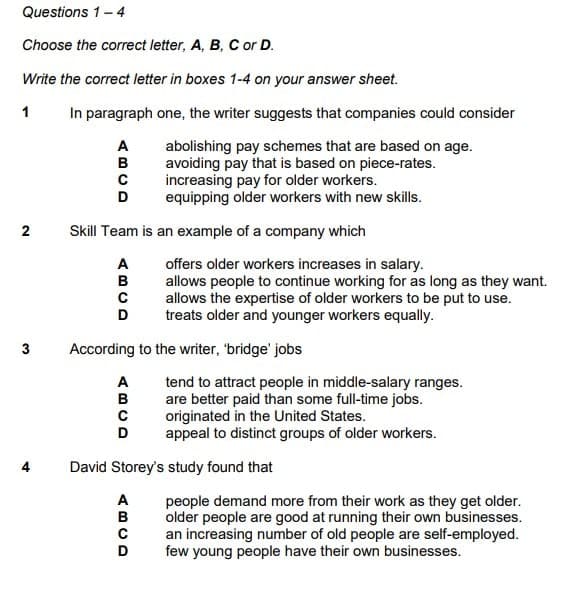The reading module in IELTS includes three passages. There are 40 questions in total, and you will have 60 minutes to complete the entire test. Unlike the listening module, you won’t have extra time to fill in the answer sheet, so make sure you do so within 60 minutes. The passages may also include a graph or an illustration, and they tend to increase in difficulty. There are 12 question types in this part of the exam.
What is the difference between the academic and general training test?
The types of questions you can expect on both tests are the same; however, the nature of the reading passages are different.
Since the general training test is usually taken by people who want to use their test results for migration purposes, the topics of the reading passages are general or work related. Moreover, the lengths of the passages are shorter in this test.
The academic test, on the other hand, is designed for ones who want to join or gain entry into a professional institution, study at college, or apply to university; therefore, the passages in this test are longer and academic in nature.
Test tips and information
- You will not be penalized for your wrong answers, so try to guess the answer whenever in doubt. Here is how you can estimate your band score based on the number of your correct answers:

- Do not read the passages too fast. You need to keep a balance between your reading speed and your comprehension level.
- Numbers and proper nouns like people’s names are very important. They usually cannot be paraphrased, and they are easier to find, so make sure to underline/highlight them as your keywords while reading the questions.
- Use your word limit. For example, if the limit is no more than three words, and the answer is” unique cultural institution,” do not just write “cultural institution”; write “unique cultural institutions.”
- Never go above your word limit; otherwise, your answer will be marked as incorrect.
- Your answers should make grammatical sense as well. Therefore, it is a good idea to read the whole sentence after you have written your answer to see if it fits grammatically as well.
- You should write the exact words that you find in the passage as you answer. For example, if you think the answer is “construction site,” you cannot write construction location. Paraphrasing the answer is very risky, so try to avoid it.
- It is a good idea to do the questions that ask for specific details. Paragraph headings or questions that require you to read the whole passage should be left to last so that you become more familiar with the passage by answering the other question.
- Pay more attention to each paragraph’s first and last sentences because they usually include the most important information. This way, you will understand each paragraph’s role and figure out which paragraph is about what type of information.
- Do not keep telling yourself to hurry up; otherwise, you will find yourself reading the same paragraph over and over because you haven’t understood what it is about.
- Do not skim all the questions at first. You will probably forget most of them. Just start with the first group and move on to the next after completing them.
- If you have a lot of time before your test day, allocate more time to learning new vocabulary. Knowing more vocabulary will make the reading test much easier for you.
- Use the keyword strategy to find the answers faster.
Types of questions In the IELTS reading module
Matching features

- In this type of question, there are categories identified as letters (A, B, C,…), and the statements are in numbers. The questions will ask you to read the passage and put the right category in front of the correct statement.
- The questions are not in the order of the passage.
- Sometimes, you may use one category more than once. Read the question carefully because it will tell you if you can use a category more than once or not.
- Some categories may not even be used, but you must have at least one category in front of each statement.
- You don’t need to underline keywords in the categories. Do that for the numbered statements. Once you have located the answer, take a look at the categories and pick the correct one.
Table Completion

- Familiarize yourself with the table.
- The answers may not be close together in the passage.
- The appearance of the answers will not necessarily be in the same order as the questions.
- Use the headings of each column as your keywords.
- When you have located the answer, use the exact words from the passage to fill in the blanks.
Flow-Chart

Look for a cause-and-effect relationship, sequence adverbs, or linking words in the passage.
- This task does not necessarily focus on one part of the passage. Sometimes, the answers are in different parts of the text.
- The questions do not necessarily come in the order of the passage.
True/False/Not Given

- The questions focus on facts in the passage.
- The questions come in the order of the passage.
- For these questions, you need to pay extra attention to modal verbs like could, should, may, etc., and restrictive words like only, just, etc.
Question: What is the difference between the three options?
Answer: Let’s look at three questions to figure this out:
- Passage: …More than most other hobbies, collecting can be totally engrossing and can give a strong sense of personal fulfillment.
Question: Collecting gives a feeling that other hobbies are unlikely to inspire.
Answer: The passage and the question both tell us that collecting is more interesting than most other hobbies, so the answer is TRUE!
2. Passage: … City problems are thought to be caused mostly by weak and unrepresentative city governments.
Question: Problems in urban areas are rarely caused by the administration.
Answer: In the passage, the writer blames most city problems on the administration, but the question says the opposite, so the answer is FALSE!
3. Passage: …Tourism has a profound impact both on the world economy and society itself.
Question: Tourism has a social impact because it promotes recreation.
Answer: This is tricky, so pay attention!
Yes, both the passage and the question tell us that tourism affects society, but it is not clear in the passage why it has such a social effect, so the reason that the question gives us cannot be verified. The answer is NOT GIVEN!
Simply put:
True= definitely yes!
False= definitely no!
not given= maybe yes, maybe no!
Yes/No/Not Given

- These questions usually focus on the writer’s opinion.
- The sentences follow the order of the information in the passage.
- Pay attention to modal verbs and restrictive words here too.
- Always be wary of the comparisons. The writer may start talking about nice things about the subject and use transitional words to imply the bad things about it (his real opinion).
- Do not overthink! Things should be clearly stated for them to be true.
Matching Headings

- These questions require you to select the most appropriate heading (usually in a box with Roman numbers like i, ii, iii,…) for the paragraphs ( in English Alphabet like A, B, C,…)
- You only need to write the Roman numbers on your answers sheet.
- The heading you choose should cover the entire paragraph, not just a specific part of it.
- Do not choose an answer simply because you have spotted a similar word. Usually, it’s a trap!
Matching sentence endings

- This question requires you to complete the sentence by choosing from the list given in the box.
- The questions follow the order of the information in the text.
- The information may be in a particular part of the text or spread out through the passage.
- Only underline the keywords in the questions because not all the options in the box will be used. In other words, don’t waste your time underlining the keywords in the box.
Multiple Choice (more than one answer)

- The questions follow the same order as the information in the passage.
- You may not have enough time to underline all the options. Just use the keyword strategy on the stem of the questions and not the options. Locate the answer and pick the correct options.
Multiple choice (one answer)

- The questions follow the same order as the information in the passage.
- Highlight keywords in the stem of the questions and not the options.
- If two options say the same thing, neither is the answer.
Sentence completion

- The answers appear in the same order as the question.
- Your answers must fit the gap grammatically as well.
- If you use the keyword strategy effectively, you will find the answers very easily.
Summary Completion (selecting from a list of words or phrases)

- For these questions, you are required to complete the sentences by choosing from the list given, using the information provided in the passage.
- The questions follow the order of the information in the passage.
- The information may be in a particular part of the text or spread out throughout.
- The words in the box may not be the same as the words in the text.
- Remember that your answer must fit the gap grammatically as well, and you cannot make any changes to the words.
- When you are done, read the summary to check if it makes sense.
Summary completion (selecting words from the text)

- This is exactly the same as the previous one we talked about, with only one difference: there is no box to choose words from. Instead, you will find the words from the passage itself.
- Pay attention to the word limit!
Follow us on YouTube for more tips and resources







